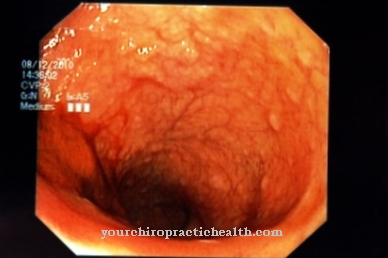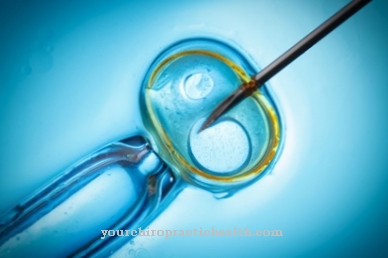Under the Electrooculography the ophthalmologist understands a measuring method for determining the resting retinal potential, which is often used to diagnose diseases of the equilibrium organ. The procedure works with the help of two electrodes and is completely objective. Risks and side effects are not to be expected with the measurement.
What is electrooculography?

Electrooculography objectively measures the resting potential of the retina. The measurement method is also Electronystagmography called. The resting potential of the retina is the permanent voltage difference between the back and the front. This voltage difference gives the cornea a positive charge and the back of the eyeball a negative charge.
In order to measure this resting potential, the ophthalmologist works with two electrodes in electrooculography. These electrodes are located either to the right and left of the eye or are attached above and below. The measurement makes it possible to identify the smallest eye movements, as every movement changes the resting potential. Electrooculography is therefore often used in the context of neurological findings and in this case is intended to document barely visible tremors in the eyes.
Function, effect & goals
Electrooculography can be required for various diseases. For example, if a patient's equilibrium system is diseased, it can produce symptoms such as nystagmus. With nystagmus there is a pathological tremor of the eye, which cannot always be seen with the naked eye. The tremors are involuntary and are usually unconscious to the patient.
First, the two measuring electrodes are attached to a patient's skin around the eye as part of an electrooculography. When assessing the organ of equilibrium, the resting potential is first measured in the absolute resting state. In the case of nystagmus, changes in tension can already be observed that are due to minimal eye movements. As part of the equilibrium study, the measurement at rest is followed by a measurement after the patient has slowly turned. Usually, the ear canal is also rinsed with 27 degrees cold and later 44 degrees warm water before the doctor takes a third measurement.
Electrooculography, however, does not necessarily have to take place as part of a balance examination, but is often used to diagnose retinal diseases. In this scenario, after the doctor attaches the electrodes, the patient must make various eye movements. With one eye movement, the front of the eye moves closer to one of the electrodes. The back of the eye, however, approaches the opposite electrode. This process creates a voltage difference between the two electrodes. This voltage difference is recorded in electrooculography and is normally in a certain proportion to the viewing angle.
As a rule, the team asks the patient during the ophthalmological electrooculography to look back and forth between two fixed points in space at regular intervals. If the resting potential of the retina is constant, then the same voltage difference can be detected every time you change your viewing direction. As soon as the light conditions change, the resting potential of the retina also changes in healthy people and, at the same time, the difference when changing the direction of gaze. During the ophthalmological electrooculography, the doctor usually also evaluates how the voltage changes in the dark. This change is also known as dark adaptation. In a healthy patient, there is a slight decrease in the resting potential in the dark, which lasts for several minutes.
As soon as the patient is lit again, the resting potential usually increases sharply. If these typical schemes cannot be observed during electrooculography, there is probably a pathological change in the retinal pigment epithelium. Sometimes electrooculography is also used in sleep medicine. In polysomnography, for example, the REM phases of the sleeper are recorded. REM stands for rapid eye movement, i.e. rapid movements of the eyes. In some cases, sleep medicine uses measurements to determine how the sleeping patient reacts to certain sounds.
You can find your medication here
➔ Medicines for balance disorders and dizzinessRisks, side effects & dangers
Electrooculography is usually performed on an outpatient basis and is not associated with any pain for the patient. Neither risks nor side effects are to be expected. If the procedure is used as part of a balance examination, however, balance disorders can arise for the day, which usually regress again the following day.
Rinsing the ear canals can be perceived as uncomfortable during the balance examination. In any case, the advantages of the measurement method surpass the downsides. The method is a completely objective measurement method that cannot be falsified by the patient. This is what distinguishes electrooculography, for example, from many other subjectively perceived balance examinations. In the case of electrooculography, the results can only be falsified if the electrodes are not attached properly or if they are too loose.
The professionalism of the supervising team is therefore crucial for reliable diagnostics. Under certain circumstances, after an ophthalmological electrooculography to diagnose retinal diseases, further ophthalmic examinations may be due. An electroretinography could, for example, serve to further investigate the retinal function. Different light stimuli are specifically delivered to the retina and the potential formed by the retina is determined with the help of several electrodes. A finding can also trigger follow-up examinations or targeted therapy measures as part of a balance test.













.jpg)

.jpg)
.jpg)











.jpg)